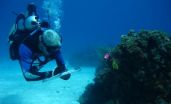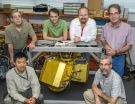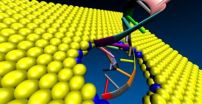(Press-News.org) SACRAMENTO, Calif. – New research on the predatory nature of red lionfish, the invasive Pacific Ocean species that is decimating native fish populations in parts of the Caribbean Sea and Atlantic Ocean, seems to indicate that lionfish are not just a predator, but more like the "terminator" of movie fame.
The finding of behavior that was called "alarming" was presented today by Kurt Ingeman, a researcher from Oregon State University, at the annual meeting of the Ecological Society of America.
Most native predatory fish are attracted to prey when their numbers are high, when successful attacks are easy and when a minimum of energy is needed to catch and eat other fish, according to previous research done by Michael Webster, a fish ecologist who received his doctorate from OSU. As the population of prey diminishes, the native predators often move on to other areas where, literally, the fishing is better.
The new research concludes that lionfish, by comparison, appear to stay in one area even as the numbers of prey diminish, and in some cases can eat the population to local extinction. They have unique characteristics that make this possible, and like the terminator, they simply will not stop until the last of their prey is dead.
"Lionfish seem to be the ultimate invader," said Ingeman, a doctoral candidate in the Department of Integrative Biology within the OSU College of Science. "Almost every new thing we learn about them is some characteristic that makes them a more formidable predator. And it's now clear they will hunt successfully even when only a few fish are present. This behavior is unusual and alarming."
This research was conducted on replicated natural reefs in the Bahamas, measuring prey mortality of the fairy basslet – a popular aquarium fish and a common prey of lionfish.
Predation rates were compared between reefs with the invasive lionfish and reefs with native predators alone, and across a range of population levels of the fairy basslet. Ingeman found that when prey fish were present at a low population density, the rate of mortality with lionfish present was four times higher than that caused by native predators alone, such as medium-sized groupers or trumpet fish.
The findings are of some importance, researchers said, because fairy basslet live in small local populations, which are most vulnerable to local extinction. It also shows that the mechanisms that ordinarily regulate population size can be altered.
"Reef fish usually hide in rocks and crevices for protection, and with high populations, there is a scramble for shelter," Ingeman said. "Native predators take advantage of this situation by mostly eating when and where prey are abundant. As prey population levels decline, it takes a lot more energy to catch fish, so the predators often move on to other areas."
Because of this process that scientists call "density-dependent" predation, populations of native prey fish tend to shrink when they get too large, grow when they get too small, and are rarely ever wiped out completely.
Lionfish, however, have such advantages as an invasive species that they apparently feel no need to move on for better or easier hunting. They may not be recognized as a predator by other fish, leading to high mortality even when shelter is abundant. Lionfish are also very efficient hunters, are well defended themselves by poisonous spines, and can thrive at deep levels in the ocean. They tolerate a wide range of habitats and water conditions, reproduce rapidly most of the year, eat many different species of native fish and may overeat rare species.
Still unclear, Ingeman said, is whether evolutionary pressures may allow native fish in the Atlantic Ocean to adapt new behaviors that provide better defense against lionfish.
"There's a strong pressure here for natural selection to come into play eventually," Ingeman said. "We know that fish can learn and change their behavior, sometimes over just a few generations. But we don't have any studies yet to demonstrate this is taking place with native fish populations in the Atlantic."
The lionfish invasion in the Atlantic Ocean is believed to have begun in the 1980s and now covers an area larger than the entirety of the United States. Ingeman's advisor, Mark Hixon, and fellow graduate students have shown that lionfish can wipe out over 90 percent of more of the native fish in some hard-hit areas.
INFORMATION:
The research was supported by the National Science Foundation and the Cape Eleuthera Institute of the Bahamas.
Editor's Note: Digital images are available to illustrate this story.
Fairy basslet: http://bit.ly/1ywgHl2
Reef surveys in the Bahamas: http://bit.ly/1mJAR5o
Lionfish characteristics make them more 'terminator' than predator
2014-08-14
ELSE PRESS RELEASES FROM THIS DATE:
NSAIDs may lower breast cancer recurrence rate in overweight and obese women
2014-08-14
PHILADELPHIA — Recurrence of hormone-related breast cancer was cut by half in overweight and obese women who regularly used aspirin or other nonsteroidal anti-inflammatory drugs (NSAIDs), according to data published in Cancer Research, a journal of the American Association for Cancer Research.
"Our studies suggest that limiting inflammatory signaling may be an effective, less toxic approach to altering the cancer-promoting effects of obesity and improving patient response to hormone therapy," said Linda A. deGraffenried, PhD, associate professor of nutritional sciences ...
Mayo Clinic challenges some recommendations in updated cholesterol treatment guideline
2014-08-14
A Mayo Clinic task force challenges some recommendations in the updated guideline for cholesterol treatment unveiled by the American College of Cardiology (ACC) and American Heart Association (AHA) in 2013. The task force concludes, based on current evidence, that not all patients encouraged to take cholesterol-lowering medications, such as statins, may benefit from them and that the guideline missed some important conditions that might benefit from medication.
Furthermore, the task force believes an emphasis needs to be placed on an individualized treatment approach ...
NSAIDs benefit overweight breast cancer patients, study finds
2014-08-14
AUSTIN, Texas — Researchers have determined that postmenopausal overweight or obese breast cancer patients receiving hormone therapy as part of their treatment and who use nonsteroidal anti-inflammatory drugs (NSAIDs) such as aspirin or ibuprofen have significantly lower breast cancer recurrence rates and a sizable delay in time to cancer recurrence.
The findings, published in the Aug. 14 edition of Cancer Research, suggest a new possibility for reducing the incidence of breast cancer recurrence among overweight and obese postmenopausal women, who have a comparatively ...
Scientists make major breakthrough in understanding leukemia
2014-08-14
Scientists from Queen Mary University of London (QMUL) have discovered mutations in genes that lead to childhood leukaemia of the acute lymphoblastic type – the most common childhood cancer in the world.
The study was conducted amongst children with Down's syndrome – who are 20-50 times more prone to childhood leukaemias than other children – and involved analysing the DNA sequence of patients at different stages of leukaemia.
The researchers uncovered that two key genes (called RAS and JAK) can mutate to turn normal blood cells into cancer cells. However, these ...
Can our computers continue to get smaller and more powerful?
2014-08-13
From their origins in the 1940s as sequestered, room-sized machines designed for military and scientific use, computers have made a rapid march into the mainstream, radically transforming industry, commerce, entertainment and governance while shrinking to become ubiquitous handheld portals to the world.
This progress has been driven by the industry's ability to continually innovate techniques for packing increasing amounts of computational circuitry into smaller and denser microchips. But with miniature computer processors now containing millions of closely-packed transistor ...
UT Arlington team's work could lead to earlier diagnosis, treatment of mental diseases
2014-08-13
A computer science and engineering associate professor and her doctoral student graduate are using a genetic computer network inference model that eventually could predict whether a person will suffer from bipolar disorder, schizophrenia or another mental illness.
The findings are detailed in the paper "Inference of SNP-Gene Regulatory Networks by Integrating Gene Expressions and Genetic Perturbations," which was published in the June edition of Biomed Research International. The principal investigators were Jean Gao, an associate professor of computer science and engineering, ...
Three radars are better than one: Field campaign demonstrates two new instruments
2014-08-13
Putting three radars on a plane to measure rainfall may seem like overkill. But for the Integrated Precipitation and Hydrology Experiment field campaign in North Carolina recently, more definitely was better.
The three instruments, developed by the High Altitude Radar group at NASA's Goddard Space Flight Center in Greenbelt, Maryland, flew as part of the Global Precipitation Measurement (GPM) mission's six-week ground-validation program that took place May 1 through June 15 in the southern Appalachians, specifically to measure rain in difficult-to-forecast mountain regions. ...
New material could enhance fast and accurate DNA sequencing
2014-08-13
CHAMPAIGN, Ill. — Gene-based personalized medicine has many possibilities for diagnosis and targeted therapy, but one big bottleneck: the expensive and time-consuming DNA-sequencing process.
Now, researchers at the University of Illinois at Urbana-Champaign have found that nanopores in the material molybdenum disulfide (MoS2) could sequence DNA more accurately, quickly and inexpensively than anything yet available.
"One of the big areas in science is to sequence the human genome for under $1,000, the 'genome-at-home,'" said Narayana Aluru, a professor of mechanical ...
Patent examiners more likely to approve marginal inventions when pressed for time
2014-08-13
CHAMPAIGN, Ill. — Haste makes waste, as the old saying goes. And according to research from a University of Illinois expert in patent law, the same adage could be applied to the U.S. Patent and Trademark Office, where high-ranking examiners have a tendency to rubber-stamp patents of questionable merit due to time constraints.
The less time patent examiners are given to review an application, the more likely they are to grant patent protection to inventions "on the margin," says a study co-authored by Melissa Wasserman, the Richard and Anne Stockton Faculty Scholar and ...
Bones from nearly 50 ancient flying reptiles discovered
2014-08-13
Scientists discovered the bones of nearly 50 winged reptiles from a new species, Caiuajara dobruskii, that lived during the Cretaceous in southern Brazil, according to a study published August 13, 2014 in the open-access journal PLOS ONE by Paulo Manzig from Universidade do Contestado, Brazil, and colleagues.
The authors discovered the bones in a pterosaur bone bed in rocks from the Cretaceous period. They belonged to individuals ranging from young to adult, with wing spans ranging from 0.65-2.35m, allowing scientists to analyze how the bones fit into their clade, but ...







